
http://www.iaeme.com/IJM/index.asp 74 editor@iaeme.com
International Journal of Management (IJM)
Volume 9, Issue 3, May–June 2018, pp. 74–82, Article ID: IJM_09_03_008
Available online at
http://www.iaeme.com/ijm/issues.asp?JType=IJM&VType=9&IType=3
Journal Impact Factor (2016): 8.1920 (Calculated by GISI) www.jifactor.com
ISSN Print: 0976-6502 and ISSN Online: 0976-6510
© IAEME Publication
A STUDY ON GREEN HRM - AN EMERGING
TREND IN HR PRACTICES
Dr. Pothuraju Vijaya Lakshmi
Assistant Professor, Department of MBA,
CMR College of Engineering & Technology, Hyderabad, Telangana, India
Dr. Nagaraju Battu
Head, Department of HRM, Director: Centre for HRD,
Acharya Nagarjuna University, Nagarjunanagar, Guntur, Andhra Pradesh. India
ABSTRACT
Green HRM is the use of Human Resource Management policies to promote the
sustainable use of resources within business organizations and more generally,
promotes the cause of environmental sustainability. Objective of the Study is to
Explore Green Human Resource Management practices of organizations and to
promote the ideology that is important for proper alignment of human resource
management principles with objectives of green management in an organization. It is
a descriptive method based on both primary and secondary data. Green HRM
encompasses all activities aimed at helping an organization carry out its agenda for
environment management to reduce its carbon footprint in areas concerns on
boarding and acquisition of human resources, their induction, performance appraisal
& management, training and development and pay and reward management. This is
only possible by the effective implementation of green HRM within the organization.
These practices would result in improving employee attitudes and behaviors within the
organization.
Key words: Human Resource Management, Green HRM, Environment, Organization,
Corporate Image.
Cite this Article: Dr. Pothuraju Vijaya Lakshmi and Dr. Nagaraju Battu, A Study on
Green HRM - An Emerging Trend in HR Practices. International Journal of
Management, 9 (3), 2018, pp. 74–82.
http://www.iaeme.com/IJM/issues.asp?JType=IJM&VType=9&IType=3
1. INTRODUCTION
More of the corporate bodies’ recent interest has been paid to environmentalism globally,
whether arising from specific treaties or from harm/pollution resulting from high-profile
industrial accidents such as killing and injuring many people to struggle climate change.
Owing to the harmful consequences of industrial pollution and waste materials, including
toxic chemicals, governments and NGOs round the globe promoted regulations and policies

A Study on Green HRM - An Emerging Trend in HR Practices
http://www.iaeme.com/IJM/index.asp 75 editor@iaeme.com
with effect of slowing down and to some extent even reverse the destruction of natural
resources and its negative effect on the mankind and the society as a whole (Christmann &
Taylor, 2002; Shrivastava & Berger, 2010). In the management field, there is a growing
research literature on Green marketing, Green accounting, Green retailing and Green
management in general. To implement any corporate environmental program several units of
an organization HR, Marketing, IT, Finance, and so on, work together to put forward a
positive joint effort and among them, the most important contributor is the human resource
management unit.
However, Green HRM is the use of human resource management policies to promote the
sustainable use of resources within business organizations and more generally, promotes the
cause of environmental sustainability. Green HR essentially consists of two major elements
namely environment-friendly HR practices and the preservation of knowledge capital
(Mandip, 2012). The purpose of going green is to use products and methods that would not
negatively impact the environment through pollution or depleting natural resources
(Robinson, 2008). Thus, Green HRM involves environmentally-friendly human resource
policies and practices that, on the one hand, will help organizations achieve its monetary goal
through environmental branding and on the other hand protect environment from any negative
impacts that might cause by the policies & actions by the organizations. Further, we move on
to reviewing the literature on the HR aspects of GHRM, which helps in identifying how
corporations today develop human resource policies for going green. The study also aims to
provide simplified insight on some common GHRM processes and attempts to suggest some
green initiatives for HR.
1.1. Green Human Resource Management (GHRM) Conceptual Background
Green HRM involves undertaking environment friendly HR initiatives resulting in greater
effectiveness, lower cost and better employee engagement and retention in turn. The green
human resource management comprises of many functions in the human resource department
of an organization. It helps to reduction of paper usage and the implementation of green
human resource policies such as planning, recruiting, selecting, managing employees and the
employee relations. It makes the environment green in the workplace. All the activities
involved in the green human resource management enhance the value of the employees and
the company.
Fayyazia et al. (2015) said that there is a requirement for the amalgamation of
environmental management in Human Resource Management (HRM) because it is essentially
or very important rather than just desirable. Successful environmental management in an
organization needs special efforts of human resource management (Rothenberg, 2003).
Similarly Jabbour and Santos (2008) also stated that effective environmental performance
results need human resource practices that support the whole execution and preservation of
environmental management systems in the organizations. Organizations which are able to line
up HRM practices with objectives of environmental management can be accomplished a
desired aim or result in corporate environmental management expedition (Jabbour, 2011). A
study carried out by Harvey et al. (2012) concluded that HRM plays prime role in execution
of green practices and indicates the contribution of HRM to the green performance.
1.2. Significance of the Study
Today the need for green human resource management is important for all over the world.
The ecological consciousness of each human drives the living style and environment. The
general employees are interested in green human resource management because of its

Dr. Pothuraju Vijaya Lakshmi and Dr. Nagaraju Battu
http://www.iaeme.com/IJM/index.asp 76 editor@iaeme.com
important and need in the current workplace. Our personal and professional lifestyle is
affected due to many consequences. The corporate world is the most significant in enhancing
the environment issues and the corporate has to give solution to this hazards.
But now the concept of “Green HRM” has evolved and the composition of the policy
priorities has changed. Today, work is still a necessity but it is also a basis of personal
satisfaction. One of the means which helps to attain personal and professional goals to be
ecological benefit. This Green HRM is in existence as a result of a social responsibility to
employees and also to provide a competitive advantage to employers. Many people think that
Green HRM is only in the framework of what the company does for its employees.
1.3. Review of Literature
Marhatta and Adhikari, (2013) and Zoogah, (2011) refer its use of HRM policies and
Practices for sustainable use of resources within business organizations and generally
promotes the cause of environmentalism.
Opatha and Arulrajah (2014) refers that Green HRM is the use of policies, practices, and
systems in the organization that make green employees for the benefit of the individual, team,
society, natural environment, and the organization. Different researchers describe Green HRM
in different ways, but somehow their intentions are same for sustainability of Human
resources and their environment.
Wei & Yazdanifard, (2014) Individual motivation is said to be the key driver for
employees to actively engage and conduct in-role and extra-role behaviors, and as such it
would be expected that individual motivations for each of these types of behaviors is likely to
be discordant.
Xinhua, (2015) To tackle increasing levels of both pollution and Chinese citizens’
discontent with decaying air quality and polluted land and water systems, the Chinese
government has embarked upon a range of reforms to address these issues. These reforms
have shifted from merely responding to pollution levels to policies that seek to prevent
pollution. While these initiatives being applied by the Chinese Government are commendable,
they are insufficient to fully address the growing levels of harmful air, water and ground
pollutants that are affecting the daily lives of the Chinese people.
Yusliza, Ramayah & Othaman, (2015) The human resource is the most important assets of
an organization that plays an important role in managing the employees. The modern human
resource managers have been assigned with additional responsibility of incorporating the
green human resource philosophy in corporate mission statement along with human resource
policies. Green human resource efforts have resulted in increased efficiencies, cost reduction,
employee retention and improved productivity and also other tangible benefits. The green HR
policies and practices involved in environment, social and economic balance.
2. STATEMENT OF THE PROBLEM
To review extensive literature in the field of Green HRM to identify gaps and scopes for
further study. To develop a process model of green Human Resource Management from entry
to exit. The purpose of going Green is to use products and methods that would not negatively
Impact the environment through pollution or depleting natural resources (Robinson, 2008). In
addition, it will result in using scarce natural resources efficiently and effectively, while
keeping the environment free from harmful products. Strategic HRM researchers argued that
to achieve HR effectiveness, HR should be practiced as a whole and must be aligned with the

A Study on Green HRM - An Emerging Trend in HR Practices
http://www.iaeme.com/IJM/index.asp 77 editor@iaeme.com
business strategic goals, the primary means by which firms can influence and shape the skills,
attitudes, and behavior of individuals to do their work and thus achieve organizational goals
(Collins and Clark, 2003).
The topic of the green HRM is attracting increased attention among management scholars.
Despite its importance to managers, employees, customers and other stakeholders, however,
there are very few research studies that consider a complete process of HRM in organizations
striving to achieve environmental sustainability as present changing trend in the corporate.
There is, thus, a growing need for introducing Green HRM for sustainability of HRM.
2.1. Objectives of the Study
The main purpose of this study is to:
To explore Green Human Resource Management practices of organizations,
To Promote the ideology that is important for proper alignment of human resource
management principles with objectives of green management in an organization
To suggest appropriate Green HRM polices for Organizations.
2.2. Methodology of Study
2.2.1. Research Design
In pursuance of the above mentioned statement of problem and objectives, the following
methodology was adopted for the study. It is a descriptive method based on both primary and
secondary data. The first objective of the study was pursued by the collection and analysis of
data from secondary sources whereas all the other objectives have been achieved by collection
and analysis of primary data. The sources for primary data is collected from the Google, The
Land Rover Group, Dow chemical, Tata Group of Companies practices if Green HRM are
considered to be primary data and the sources for secondary data is gathered from journals,
New letters, Magazines etc.
2.3. Green Human Resource Management Practices of Organizations
Cherian and Jacob (2012) identified in their study that there are certain factors which
contribute specific role in employee implementation of green principles these factors are
recruitment, training, motivation and green pay/rewards in order to make sure that the
organization get right employee green input and right employee green performance of job.
In this part of the paper, we briefly describe functions of HRM which are generally
considered as traditional and there can be a variety of green practices under each function.
The green HRM process i.e. Green recruitment, performance management and appraisal,
training and development, employee relation, pay and reward and employee exit. We
summaries of the existing and certain new green HRM practices under each function of green
HRM.
2.3.1. Green Job Design and Analysis
In general, job descriptions can be used to specify a number of environmental protection
related task, duties and responsibilities. These days, some companies have incorporated
environmental and social tasks, duties and responsibilities as far as possible in each job in
order to protect the environment. In some companies, each job description includes at least
one duty related to environmental protection and also specifically includes environmental
responsibilities whenever and wherever applicable.
Nowadays many companies have designed environmental concerned new jobs or
positions in order to focus exclusively on environmental management aspects of the

Dr. Pothuraju Vijaya Lakshmi and Dr. Nagaraju Battu
http://www.iaeme.com/IJM/index.asp 78 editor@iaeme.com
organizations. From the perspective of HRM, it is really a valuable initiation and practice to
protect the environment. Moreover, some companies have involved in designing their existing
jobs in a more environmentally friendly manner by incorporating environmental centered
duties and responsibilities. These are some of the best green HRM practices which can figure
out under the functions called green job design and green job analysis.
2.3.2. Green Human Resource Planning
At present, some companies engage in forecasting number of employees and types of
employees, needed to implement corporate environmental management
initiatives/programs/activities (e.g. ISO 14001, cleaner production, responsible care etc.).
These are good practices some leading companies have adopted to manage their
environmental issues. The corporate environmental management initiatives demand some new
job positions and specific set of skills. Green Human Resource Planning gets required in this
context.
In addition these companies engage in deciding strategies to meet the forecasted demand
for environmental works (e.g. appointing consultants/experts to perform energy or
environmental audits) and sometimes they are outsourcing. As far as existing literature is
concerned, it did not clearly specify the practices under the function of Green Human
Resource Planning. However, based on the observations of the industries and organizations, it
is possible to identify certain Green Human Resource Planning Practices.
2.3.3. Green Recruitment
Induction for new recruits is seen to be needed to ensure they understand and approach their
corporate environmental culture in a serious way. Green recruitment is process of recruiting
new talent who are aware of sustainable process, environmental system and familiar with
words of conservation and sustainable environment. Green recruitment make it sure that new
talent are familiar with the green practices and environmental system that will support the
effective environmental management within the organization (Wehrmeyer, 1996) because In
the race of attracting most creative and innovative employees, companies increase their
recruiting potential, hiring quality staff is the very crucial challenge in the war of talent
(Renwick et al., 2013) and even companies are also know the fact that being a employer is an
effective way to attract new talent. Google is a very good example of a company who adopted
green recruitment few other companies are Timberland, and yes.
2.3.4. Green Selection
In the selection context, when making selection for the job vacancies some companies
consider candidates considering environmental concern and interest as selection criteria.
When interviewing candidates or evaluating them for selection, environmental-related
questions are asked by those companies. Really, these are some of the good green selection
practices. Any organization can adopt to select environmental friendly people in addition to
the normal selection criteria relating to the specific duties of the job being concerned.
2.3.5. Green Training and Development
Employee training and development programs should include social and environmental issues
at all levels, from technical health and safety considerations on the shop floor, to strategic
sustainability issues at executive management and board level (Mandip, 2012). Green
orientation programs for the newly higher employees should be an integral part of the training
and development process. To sustain in the race market it is very necessary to each and every
organization to change themselves with the change in the scenario and it is more important for
every organization to resist that change and that resistance to change will be done by training
and development. Training and development is a practice that directing a great deal of
attention on development of employee skills and knowledge that relate to specific useful

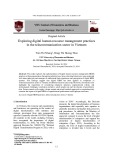
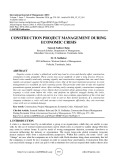
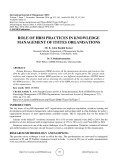
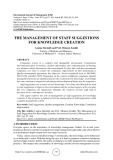
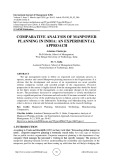
![Đề án quản lý và phát triển nhân sự tại đơn vị cấp phòng [Chuẩn SEO]](https://cdn.tailieu.vn/images/document/thumbnail/2017/20170419/msy1976/135x160/2751492583749.jpg)
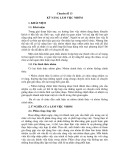

![Tài liệu đào tạo, bồi dưỡng lãnh đạo cấp phòng [Mới Nhất]](https://cdn.tailieu.vn/images/document/thumbnail/2017/20170210/nomoney3/135x160/2145657834.jpg)

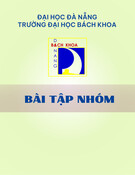
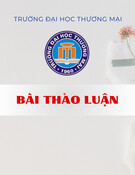






![20 câu hỏi Quản lý dự án phần mềm có đáp án [mới nhất]](https://cdn.tailieu.vn/images/document/thumbnail/2025/20251003/hieu2004haha@gmail.com/135x160/78791759734259.jpg)


![Tài liệu Quản lý dự án: Kiến thức nền tảng toàn diện [chuẩn SEO]](https://cdn.tailieu.vn/images/document/thumbnail/2025/20250910/kimphuong1001/135x160/92631757496585.jpg)



